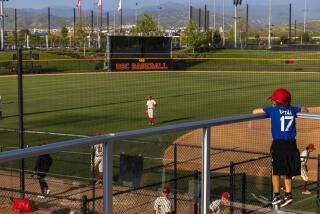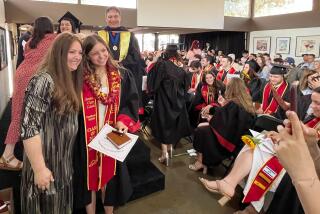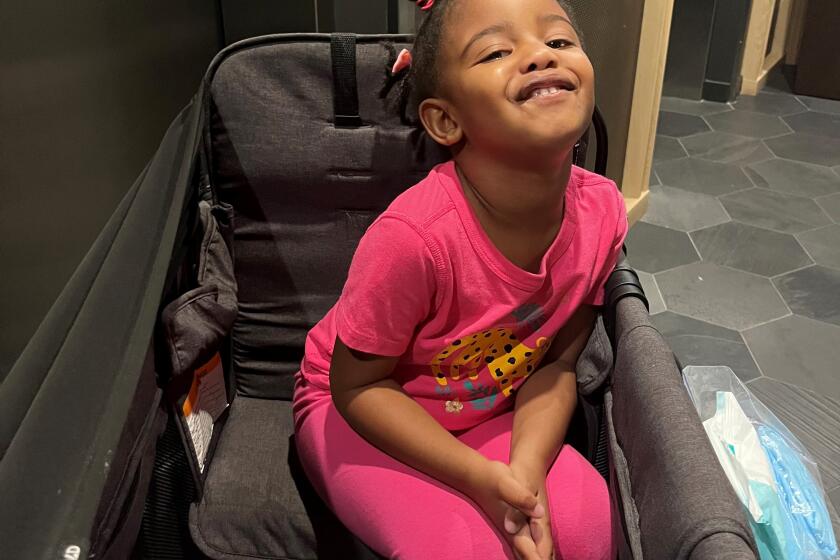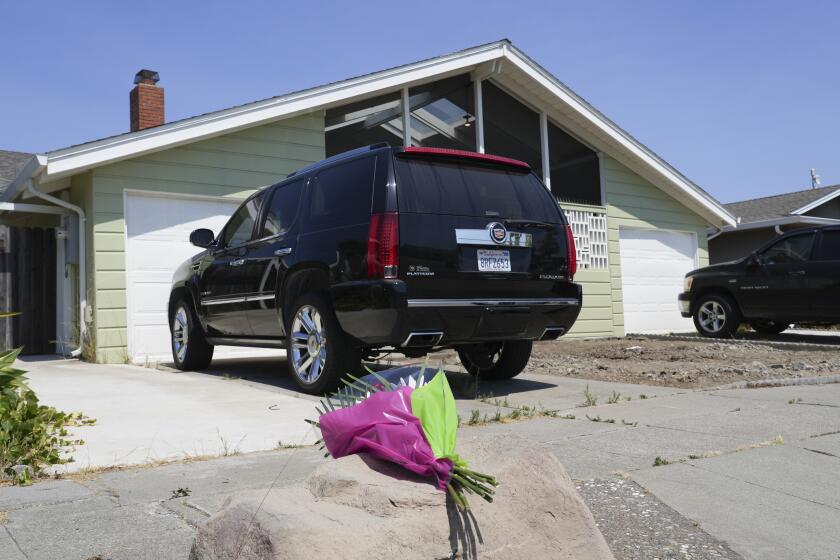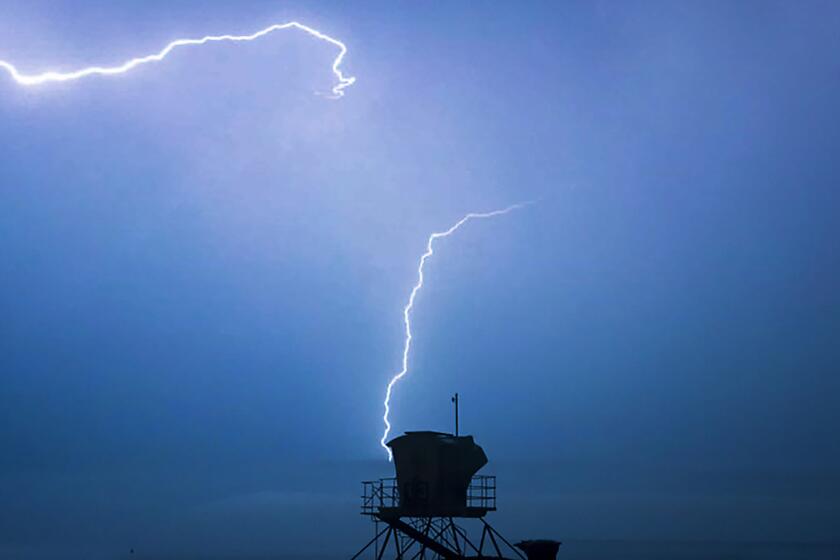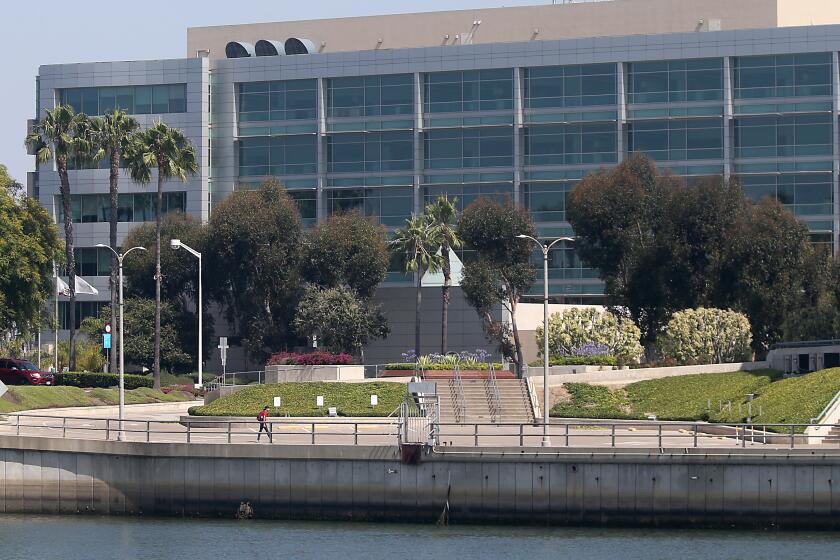Lavish new church, meeting center to serve USC Catholics
The schedule of Sunday Masses for Catholic students at USC accommodates their studying, partying and sleeping habits. Services are offered at 10:30 a.m., 7 p.m. and at 10 p.m., a popular option that is lightheartedly nicknamed the “Last Chance Mass.”
Upward of 400 USC students previously attended at least one Mass a week at a now-demolished chapel just north of the university’s main campus. The showing was respectable but still a small fraction of the estimated 10,000 Roman Catholic students — about a quarter of the overall enrollment — at the nonsectarian university.
Officials are expecting those numbers to rise sharply starting this week when a lavish new $29-million Catholic church and meeting center formally open their doors. Supporters also hope the complex will become a religious and architectural landmark for the school and the neighborhood south of downtown Los Angeles.
On Sunday, Los Angeles Archbishop Jose H. Gomez is scheduled to lead a Mass to consecrate the 300-seat church and inaugurate the adjacent student activity building, called the USC Caruso Catholic Center. Our Savior Catholic Church is an Italian Romanesque-style structure — designed by the team that did the Grove and the Americana at Brand shopping centers — with a 76-foot bell tower, a gold-leaf apse and huge stained glass windows depicting Bible scenes and saints.
Father Lawrence Seyer, the pastor, hopes the new complex at West 32nd and Hoover streets will help “show students that their Catholic faith is something relevant to their lives. They are growing in mind and body, but we want them to grow in spirit and recognize the important things in life such as love, truth, justice and faith.”
Students who drift from religion as college freshmen often embrace it again as upperclassmen, he said, adding: “They say: ‘Partying was fun but I feel empty.’ ”
The buildings, which surround a public courtyard, are designed to attract the attention of the thousands of student pedestrians and bicyclists who are headed to campus just a block away.
“But in the end, a building is just a building. Ultimately it is the programming and community life that will make them want to become involved,” Seyer said. Besides the Masses, activities will include interfaith meals and a weekly gathering to prepare and deliver food to the homeless on skid row.
The biggest donor and the new center’s partial namesake is Rick Caruso, the civic activist and shopping mall developer who created the Grove in the Fairfax district and Americana at Brand in Glendale. A 1980 alumnus with two sons enrolled at USC, Caruso gave $7.5 million to the church and center and has pledged $1 million more for programming, officials said.
So far, about $36 million has been raised in all, including $7 million for an endowment, mainly from alumni. The Catholic Archdiocese of Los Angeles owns and runs the complex, which is affiliated with USC’s Office of Religious Life.
As an undergraduate, Caruso said, he barely noticed the previous Catholic center and instead attended Sunday Mass with his family in Beverly Hills. With USC student life more focused these days on and around the campus, he said he wanted to help create “a statement that faith is important, that Catholicism is relevant in your life however you view Catholicism.”
The church has an exterior of Italian travertine, marble floors and altar and interior wooden arches reaching 50 feet. On a recent day, craftsmen from the Judson Studios in Highland Park were installing some of their final stained glass windows, each 24 feet high, illustrating the Beatitudes from Jesus’ Sermon on the Mount.
Suspended over the altar is a 7-foot bronze sculpture of the crucified Christ, created by Christopher Slatoff. Along the side walls, the 14 Stations of the Cross feature original oil paintings by artist Peter Adams, who traveled to Jerusalem to research the scenes.
Caruso said he is not a fan of the starkly modern Cathedral of Our Lady of the Angels in downtown Los Angeles. So for the USC project, he was instrumental in hiring Elkus Manfredi Architects of Boston, the firm whose designs of the Grove and the Americana triggered much debate about re-creating historical styles.
Caruso said he wanted the church, which echoes elements of a 13th century sanctuary, to have “a feeling of permanence and solidity ... that calms you down and that allows you to contemplate, to pray and to think.” Contemporary design, he said, “would not have conveyed that.”
Around the country over the last decade, the trend at colleges has been to build or renovate interfaith chapels, rather than ones devoted to one denomination, according to the Rev. Lucy Forster-Smith, national president of the Assn. of College and University Religious Affairs.
At USC, in contrast, the motivation seems to be creating “a very compelling and exciting space that would be inviting to USC students” and help them become the next generation of Catholic activists, said Forster-Smith, a Presbyterian minister who is the chaplain at Macalester College in Minnesota.
Sergio Avelar, a USC senior who is leader of the campus Catholic community, said that some students may think the new complex is too ornate but that most are excited about the church’s beauty and the well-appointed meeting rooms and library in the two-story center next door.
Avelar, who grew up in Los Angeles, said the facility will be especially important to the increasing numbers of USC students from other states and countries who cannot attend Mass at their hometown parishes. While the neighborhood-oriented St. Vincent Catholic Church is nearby at Adams Boulevard and Figueroa Street, and some USC students volunteer there, most prefer having a church adjacent to campus that caters to their own interests and schedules, such as that 10 p.m. Mass, he added.
Varun Soni, USC’s dean of religious life and the first Hindu to hold such an office at an American university, said he expects the complex to become an important place for faith and activism in a neighborhood that already has an impressive array of Protestant, Jewish, Muslim and Hindu institutions.
“It will be a place for all students to think about their own faith and how that connects to their own lives and careers,” Soni said.
larry.gordon@latimes.com
More to Read
Start your day right
Sign up for Essential California for news, features and recommendations from the L.A. Times and beyond in your inbox six days a week.
You may occasionally receive promotional content from the Los Angeles Times.
